Science Olympiad-Solar System-2017~2018 – Flashcards
Unlock all answers in this set
Unlock answersquestion
The motions of the planets in the solar system. They were derived by the German astronomer Johannes Kepler
answer
Kepler's laws of planetary motion
question
The innermost of the four Galilean moons of the planet Jupiter
answer
Io
question
The innermost and larger of the two natural satellites of Mars
answer
Phobos
question
Phobos, Deimos, Io, and Earth's Moon are all....
answer
Natural satellites
question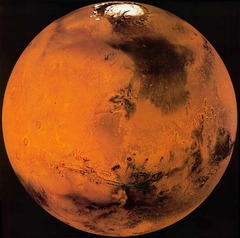
The fourth planet from the Sun...nicknamed "The Red Planet"

answer
Mars
question
A system of canyons that runs along the Martian surface east of the Tharsis region in Mars. Also called the "Grand Canyon" of Mars
answer
Valles Marineris
question
The outermost and smaller of the two satellites of Mars
answer
Deimos
question
The second planet from the Sun...nicknamed as "The sister to Earth"
answer
Venus
question
The third planet from the Sun...A planet that can sustain life...Roman for the Greek Gaia
answer
Earth
question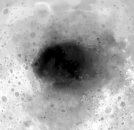
A plain located within the huge, roughly circular crater located in the southern hemisphere of the planet Mars.

answer
Hellas Planitia
question
The satellite surrounding Earth.
answer
The Moon
question
First satellite to be sent to Space...created by the Soviet Union

answer
Sputnik
question
The circumstellar disc in the Solar System located roughly between the orbits of the planets Mars and Jupiter.
answer
Asteroid Belt
question
An impact crater on the far side of the Moon.
answer
Aitken basin
question
The first planet from the Sun...Hermes
answer
Mercury
question
Short-period comet visible from Earth every 74-79 years.
answer
Halley's Comet
question
The major star in the Solar System...Basically a gigantic ball of plasma
answer
The Sun
question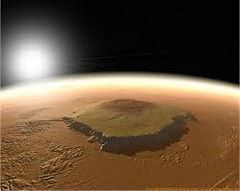
The tallest volcano on Mars...the size of Arizona

answer
Olympus Mons
question
An impact crater on Venus, in Maxwell Montes... a double-ring impact basin about 100 kilometers in diameter and 2.5 kilometers deep.
answer
Cleopatra
question
A substance usually found on Moon's surface
answer
Moon Dust
question
One of the largest objects in the asteroid belt, with a mean diameter of 525 kilometers.
answer
4 Vesta
question
The rise and fall of sea levels caused by the combined effects of the gravitational forces exerted by the Moon and the Sun
answer
Tides
question
Rocky, airless worlds that orbit our sun, but are too small to be called planets
answer
Asteroids
question
An astronomical body orbiting a star or stellar remnant that is massive enough to be rounded by its own gravity
answer
Planet
question
The spaceflight that landed the first two humans on the Moon.
answer
Apollo 11
question
Carbonaceous asteroids...they are the most common variety, forming around 75% of known asteroids.
answer
C-Type Asteroids
question
The phenomenon of eruption of molten rock (magma) onto the surface of the Earth or a solid-surface planet or moon, where lava, pyroclastics and volcanic gases erupt through a break in the surface called a vent.
answer
Volcanism
question
What is this event called?
answer
Formation of the Earth and the Moon
question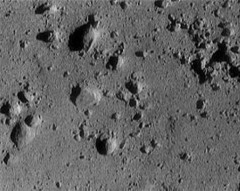
A layer of loose, heterogeneous superficial deposits covering solid rock. It includes dust, soil, broken rock, and other related materials and is present on Earth, the Moon, Mars, some asteroids, and other terrestrial planets and moons.

answer
Regolith
question
Is a period of time during which a certain portion of a planet's area reflects sunlight from the perspective of a given vantage point.
answer
Planetary Phase
question
Orbital Period of Mercury (Rotation)
answer
88 Days
question
Orbital Period of Venus (Rotation)
answer
225 Days
question
Orbital Period of Earth (Rotation)
answer
365 Days
question
Orbital Period of Mars (Rotation)
answer
687 Days
question
Mercury, Venus, Earth, and Mars are all....
answer
Inner Planets
question
This type of asteroid includes about 17% of the known asteroids in the solar system. Its surface is composed of nickel-iron with iron-silicates, and magnesium-silicates. The albedo of this type is lighter, at around 0.1 - 0.22.
answer
S-Type Asteroids
question
(metallic asteroids) are reddish in color ,8% of the solar system,and make up most of the rest of the asteroids, and dwell in the middle region of the main belt. They seem to be made up of nickel and Iron Asteroids range greatly in size from less than 33 feet to the largest asteroid Ceres, with a size of 587 miles
answer
M-Type Asteroids
question
1st primary phase of the moon and it occurs the moment when the Sun and Moon are aligned, with the Sun and Earth on opposite sides of the Moon
answer
New Moon
question
The moment a thin sliver of the Moon becomes visible after New Moon is the beginning of the first intermediate phase
answer
Waxing Crescent Moon
question
The 2nd primary Moon phase and it is defined as the moment the Moon has reached the 1st quarter of its orbit around Earth, hence the name
answer
First Quarter Moon
question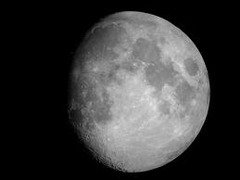
The 2nd intermediate phase...lasts until the next primary phase.

answer
Waxing Gibbous Moon
question
Appears in the night sky when the Sun and the Moon are aligned on opposite sides of Earth
answer
Full Moon
question
The portion of the visible half of the Moon illuminated decreases during this period.
answer
Waning Gibbous Moon
question
The moment the opposite half of the Moon is illuminated compared to the First Quarter Moon.
answer
Third Quarter Moon
question
The Sun illuminates less than half of the visible part of the Moon during this Moon phase and you can sometimes see earth shine on the rest of the Moon towards the end.
answer
Waning Crescent Moon
question
All planets move about the Sun in elliptical orbits, having the Sun as one of the foci. A radius vector joining any planet to the Sun sweeps out equal areas in equal lengths of time.
answer
Kepler's First Law of Planetary Motion
question
The speed of a planet traveling in an elliptical orbit around the sun. It states that a line between the sun and the planet sweeps equal areas in equal times.
answer
Kepler's Second Law of Planetary Motion
question
The square of the orbital period of a planet is directly proportional to the cube of the semi-major axis of its orbit. This captures the relationship between the distance of planets from the Sun, and their orbital periods.
answer
Kepler's Third Law of Planetary Motion
question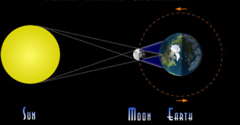
A type of eclipse that occurs when the Moon passes between the Sun and Earth, and when the Moon fully or partially blocks the Sun.

answer
Solar Eclipse
question
The new Moon passes between the Sun and the Earth, and totally blocks out the Sun.
answer
Total Solar Eclipse
question
A group of three impact craters on Venus, which are widely well known.
answer
Danilova, Aglaonice and Saskia
question
Orbital Period of The Moon
answer
27 Days
question
Orbital Period of Deimos
answer
30 Hours
question
Orbital Period of Phobos
answer
8 Hours
question
Orbital Period of Io
answer
42 Hours
question
Asteroids sharing an orbit with a planet, but which are located at the leading (L4) and trailing (L5) Lagrangian points
answer
Trojan Asteroids
question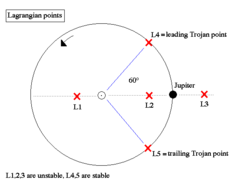
A location in space where the combined gravitational forces of two large bodies, such as Earth and the sun or Earth and the moon, equal the centrifugal force felt by a much smaller third body.

answer
Lagrangian Points
question
Shifts between a total and annular eclipse. At certain points on the surface of Earth, it appears as a total eclipse, whereas at other points it appears as annular.
answer
Hybrid Solar Eclipse
question
An eclipse of the sun in which the moon does not completely hide the solar surface or photo-sphere so that some direct rays of sunlight reach the observer : all the part of a total solar eclipse outside of the path of totality.
answer
Partial Solar Eclipse
question
An apparent or real oscillation of the moon, by which parts near the edge of the disc that are often not visible from the earth sometimes come into view.
answer
Libration
question
The sun and moon are in line, but the moon's apparent size is smaller than the sun because the moon is close to apogee. ___________ eclipses are more likely to occur during earth's perihelion. The sun appears as a bright ring around the moon's outline. __________ eclipses are only visible in the antumbra.
answer
Annular Eclipse
question
Occurs when the Moon passes directly behind the Earth into its umbra. This can occur only when the sun, Earth, and moon are aligned exactly, or very closely so, with the Earth in the middle.
answer
Lunar Eclipse



